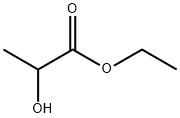A3962412
Ethyl lactate , 98% , 97-64-3
Synonym(s):
Ethyl 2-hydroxypropionate
CAS NO.:97-64-3
Empirical Formula: C5H10O3
Molecular Weight: 118.13
MDL number: MFCD00065359
EINECS: 202-598-0
Update time: 2022-07-08
PRODUCT Properties
| Melting point: | -26°C |
| alpha | D14 -10° |
| Boiling point: | 154 °C (lit.) |
| Density | 1.031 g/mL at 25 °C (lit.) |
| vapor pressure | 81hPa at 20℃ |
| FEMA | 2440 | ETHYL LACTATE |
| refractive index | 1.4124 |
| Flash point: | 54.6±6.4 °C |
| solubility | Miscible with water (with partial decomposition),
ethanol (95%), ether, chloroform, ketones, esters, and hydrocarbons. |
| pka | 13.21±0.20(Predicted) |
| form | clear liquid |
| color | Colorless |
| Odor | Mild characteristic. |
| optical activity | [α]20/D 10.5°, neat |
| biological source | synthetic |
| Odor Type | fruity |
| Water Solubility | 100g/L at 20℃ |
| JECFA Number | 931 |
| Merck | 14,3817 |
| Dielectric constant | 13.1(25℃) |
| Stability: | Stable. Combustible. Incompatible with strong oxidizing agents. |
| InChIKey | LZCLXQDLBQLTDK-UHFFFAOYSA-N |
| LogP | 0.7 at 25℃ |
| CAS DataBase Reference | 97-64-3(CAS DataBase Reference) |
| NIST Chemistry Reference | Propanoic acid, 2-hydroxy-, ethyl ester(97-64-3) |
| EPA Substance Registry System | Ethyl lactate (97-64-3) |
Description and Uses
Ethyl lactate is used as a solvent for nitrocellulose, cellulose acetate, and many cellulose ethers and resins. It is also used in lacquers, paints, enamels, varnishes, stencil sheets, safety glass and flavoring. Ethyl lactate is furthermore used in some cosmetic formulations in soaps, detergents, creams and lotions with a maximum concentration of 0.2 %. In recent years it has been used as degreaser as a substitute for trichloroethylene.
Safety
| Symbol(GHS) |    GHS02,GHS05,GHS07 |
| Signal word | Danger |
| Hazard statements | H226-H315-H318-H335 |
| Precautionary statements | P210-P233-P240-P280-P303+P361+P353-P305+P351+P338 |
| Hazard Codes | Xi |
| Risk Statements | 10-37-41 |
| Safety Statements | 24-26-39 |
| RIDADR | 1192 |
| WGK Germany | 1 |
| RTECS | OD5075000 |
| HazardClass | 3.2 |
| PackingGroup | III |
| HS Code | 29181100 |
| Hazardous Substances Data | 97-64-3(Hazardous Substances Data) |



